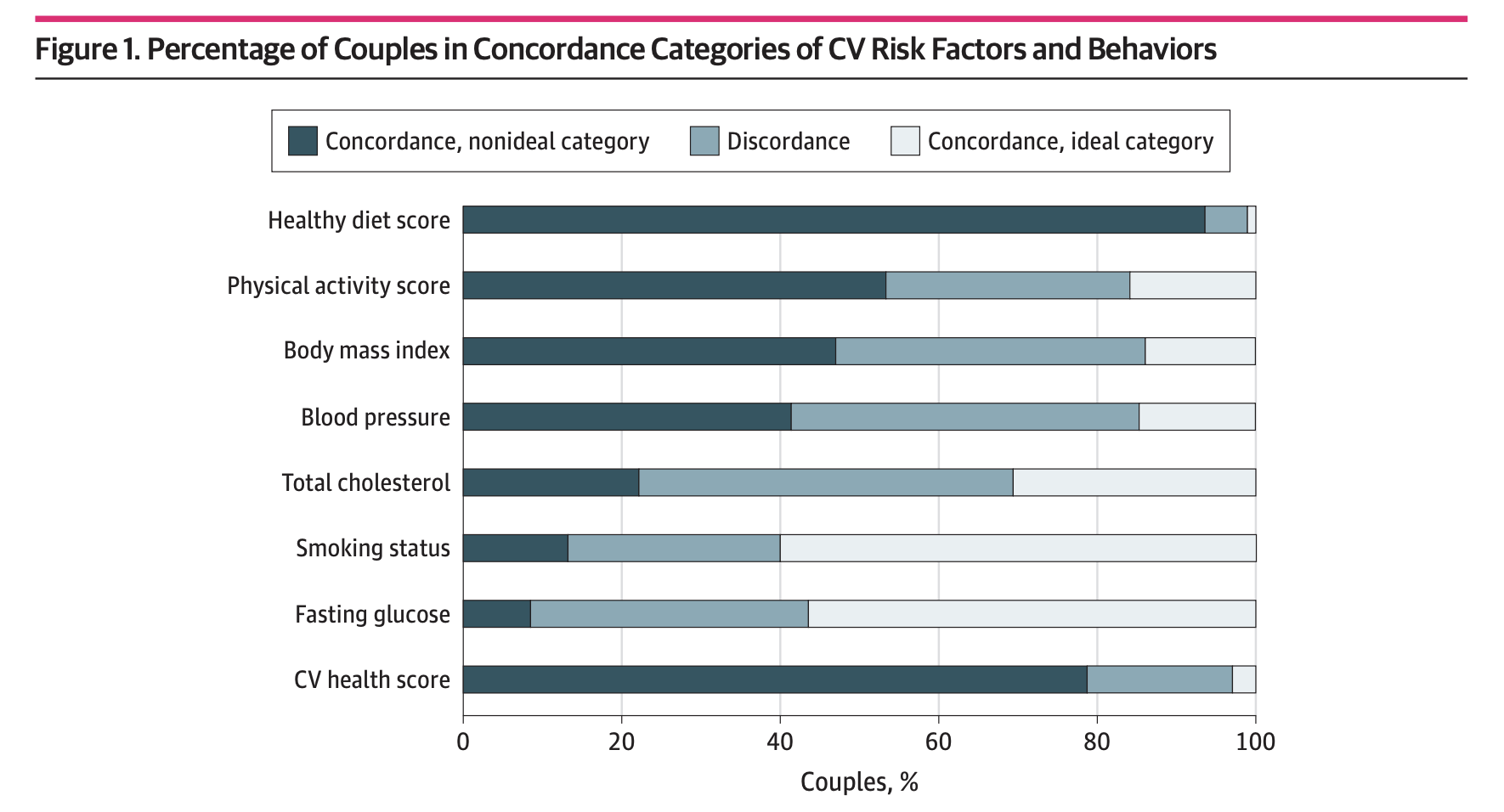A new study published in JAMA Network Open looks at what spouses have in common when it comes to their physical health. Researchers followed nearly 5,400 middle-aged, American couples that enrolled in an employee wellness program between October 2014 and August 2015; of those couples, about 2,200 were followed through 2018. Using questionnaires, exams, and lab results, they assessed their heart disease risks and lifestyle behaviors based on the factors spelled out in the American Heart Association Life’s Simple 7. The results of participants’ smoking status, level of physical activity, diet, total cholesterol, blood pressure, fasting blood sugar, body mass index (BMI), and overall health were then categorized both individually and per couple as either “poor,” “intermediate,” or “ideal.”

About one out of five couples were both “ideal,” but unhealthy diets and inadequate levels of activity pushed the vast majority of couples to have less-than-ideal health. Only 12% of individuals had “ideal” scores for heart health, and more than a quarter had “poor” results for BMI and exercise levels. Researchers were particularly concerned over what these results mean for participants given their ages; the men ranged from 41 to 57 years old, while women ranged from 39 to 57. Making good health choices earlier in life impacts future well-being, and risk factors tend to only get worse with age. However, these middle-aged participants, unfortunately, missed an important window of time where they could’ve made more impactful changes.
The study, importantly, shows how healthy employees tend to have healthier spouses. While people do tend to marry those that share common interests or backgrounds, habits like exercise and diet naturally affect the routines and lifestyle choices of those in the same household. Jannie Nielsen, an assistant professor at Emory University involved in reviewing the findings, explained, “You could hypothesize that because one person is in an intervention, they may change what they eat at home.”
Leverage Employees’ At-Home Support System
Being in a relationship creates a natural support system for individuals trying to make healthy choices; and, while the study did not look at households or larger family units, lifestyle choices generally influence and are influenced by everyone in a single household (even if it isn’t to the same degree partners influence one another).
If an employee’s spouse or other family members have access to the same wellness program offerings, that employee may be more likely to engage with their benefits because they share routines and have a built-in support system to hold them accountable at home. Similarly, if an employee’s spouse makes poor wellness decisions—such as keeping junk food around the house, smoking, or being physically inactive—it is most likely affecting the wellness efforts of the employee (and other household members) too.
Decisions over meal planning and grocery shopping will naturally influence the diet of others in the same household. Spouses and family members that work out together, or even just belong to the same gym, can encourage one another. If one person at home smokes, everyone living with them has to deal with secondhand smoke inhalation. Activities that couples and families choose to do together can also dictate the amount of physical movement an employee gets. Do they share family hikes together, or are they more likely to watch television at home? A wellness program that involves partners and families can influence an employee’s success.
How To Include Spouses And Family Members
It’s common to extend health insurance benefits to employee family members, or at least pay a percentage of their premiums that include non-employees. If employees are not taking advantage of insurance for other family members, consider raising the percentage of premiums covered. An investment into the health of an employee’s household members directly influences an employee’s own health, potentially reducing the actual healthcare costs for that employee. Employers can also consider extending access to benefits like gym memberships to household members as well or offer a reduction in fees if they want to join the same fitness facility.
Couples and families are also likely to share some of the same mental and emotional health problems, especially when there are shared sources of stress involved like parenting responsibilities, financial burdens, or disagreements in a relationship. Mental health benefits may be substantially more useful and effective if they are extended to family members, especially during instances in which couples or family counseling is needed. After all, an employee’s mental and emotional well-being will be deeply impacted by those closest to them.
Employers can also easily extend access to health content—such as virtual fitness classes, digitally-delivered health information, or even wellness challenges—to an employee’s family members. Keeping spouses involved in employee health may be especially valuable as the COVID-19 pandemic continues, since social distancing has substantially limited employees’ interactions with those outside of their household or immediate family.












